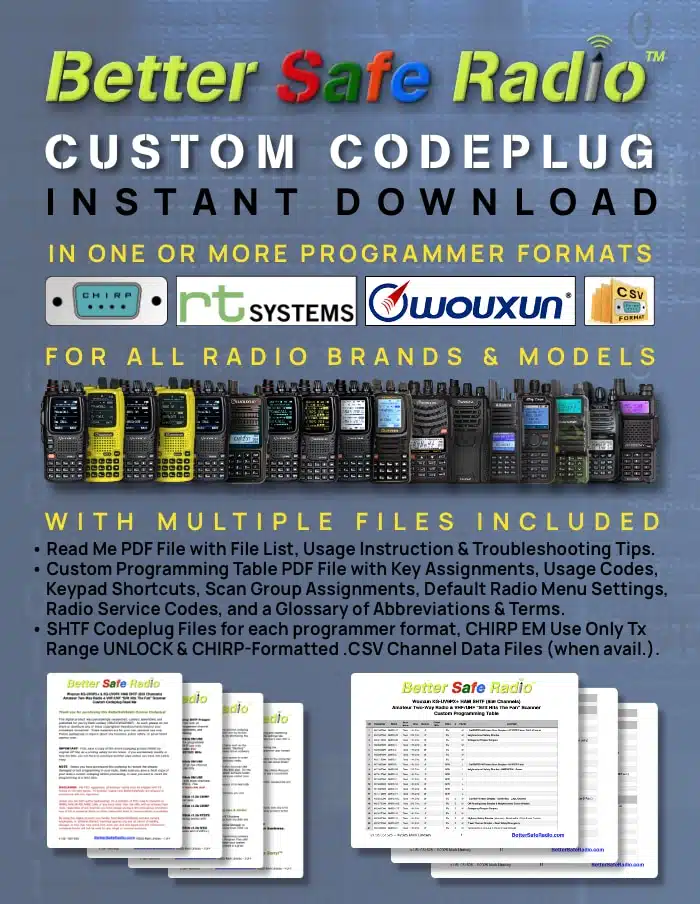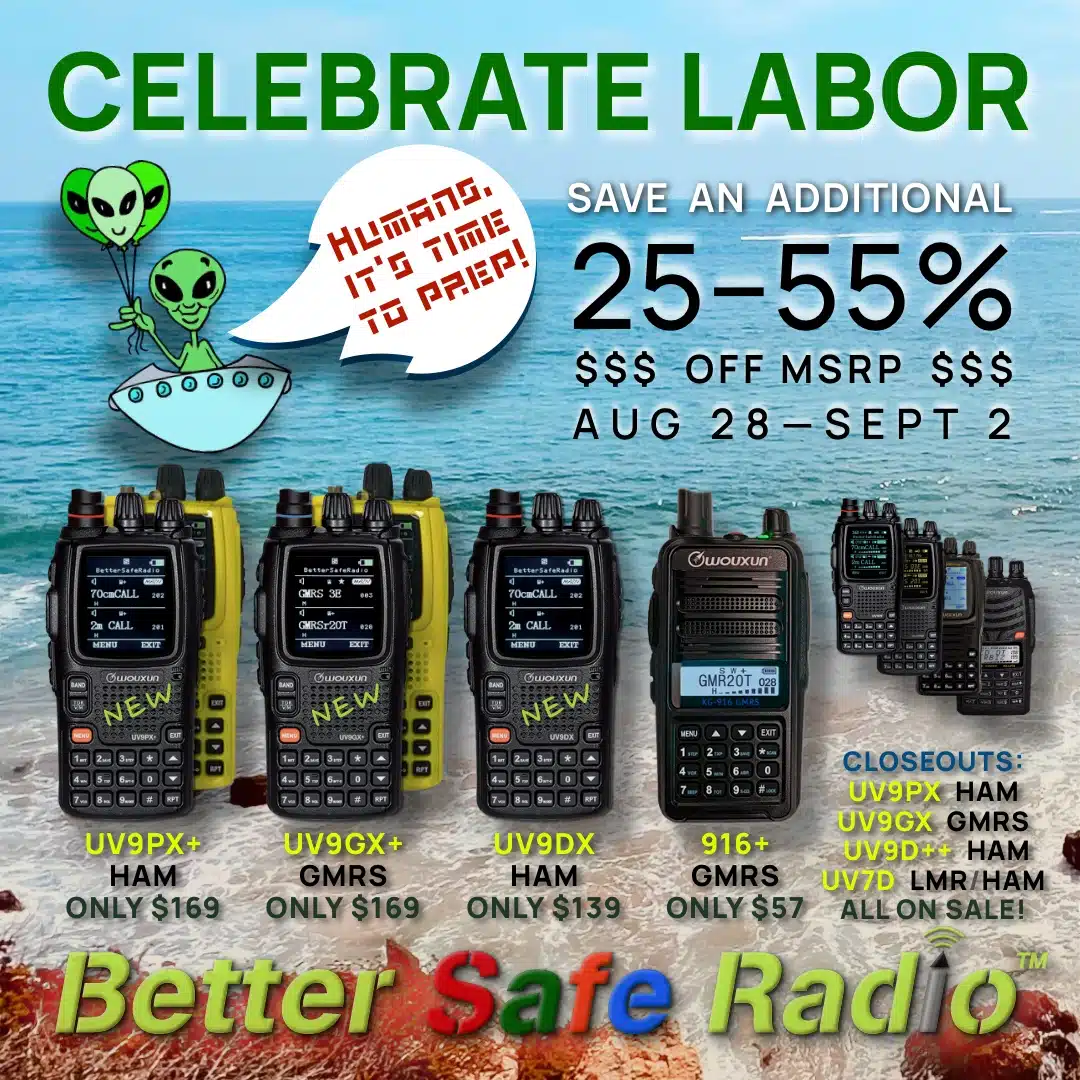Emergency Two-Way Radios for SHTF Prepping, Recreation, Off-Roading, Overlanding, RVing, Family, Farming, CERT, ARES, RACES, REACT, SkyWarn, Neighborhood Watch, Public Safety, Security, Disaster Preparedness, EmComm & Business.
Official Authorized Distributor for
Start Prepping Now & Browse All
Two-Way Walkie-Talkie Radio Scanners & Accessories
STORE NOTIFICATIONS & STOCK/BACKORDER STATUS
Orders typically processed in 1–4 days with USPS 2–8 day Ground or 1–4 day Priority shipping.
(All packages with Li-ion batteries must ship with Ground Advantage surface transport.)
Please see specific radio models below for any special stock/backorder/processing estimates.
All radios are carefully hand-packed in a zip bag for moisture protection & shipped with insurance!
Thank you for supporting my one-man very small business as I continue to bring you the best pre-programmed GMRS, HAM and LMR handhelds possible, with some great new radios in the works! 🙂
Cheers & 73, –Mark K6LED | WQXR567
FEATURED PRODUCTS & FALL DISCOUNT PRICING
Note: Most radio & accessory sale prices for products from China include a portion of the previous 30% tariffs (which are paid by American companies that import, not by the exporting country). While particularly difficult for a self-financed one-man operation, I am absorbing as much of that added tax as possible and will continue to offer below-market pricing as long as possible.
UPDATE: Good news, it looks like we may have a tariff agreement with China that will lower the tariff to 20% (which is still 100% more than in 2024, but better than 30% or 145%). These changes should be reflected with new stock coming soon. – Stay Tuned!
Thank you for supporting my small American business!
••• NEW! • BSR SHTF Custom Codeplug Download – ONLY $9 for Launch!
Restore your BSR Wouxun radio pre-programming or install my codeplug into any other radio.
CHIRP, Wouxun, RT Systems & CHIRP-Formatted .CSV formats included!
••• UV9PX+YEL & UV9GX+YEL Bright Yellow Case Options Now Available!
(see PX+ & GX+ product pages)
••• NEW! • KG-UV9PX+ HAM – $179 – Upgraded HAM SHTF Prepper EDC
The HAM Prepper’s Choice! – Pre-Programmed 8–10 Watt True Dual Receive Superhet
Everything you loved about the PX with a Brighter Display and USB-C!
Limited Quantity in Stock Now (due to uncertain tariff situation)
••• NEW! • KG-UV9GX+ GMRS – $179 – Upgraded GMRS SHTF Prepper EDC
The GMRS Prepper’s Choice! – Pre-Programmed 5.5 Watt True Dual Receive Superhet
Everything you loved about the GX with a Brighter Display and USB-C!
Limited Quantity in Stock Now (due to uncertain tariff situation)
••• NEW! • KG-UV9DX HAM – $149 – High-End HAM Prepper Starter or Backup
A Great Prepper/Starter 2-Way! – Pre-Programmed 5 Watt True Dual Receive Superhet
It’s a 5 Watt version of the new UV9PX+ for $30 less! (Big power isn’t always necessary)
Limited Quantity in Stock Now (due to uncertain tariff situation)
Almost Gone • KG-UV9PX HAM – $169 – Flagship HAM SHTF Prepper EDC
Limited Final Stock Remaining – Brand New – Full Warranty!
SOLD OUT! • KG-UV9GX GMRS – $169 – Flagship GMRS SHTF Prepper EDC
May have some final Open-Box offers available soon!
Almost Gone • KG-UV9D Plus+ HAM – $139 – The UV9D(Plus), but Better!
Limited Final Stock Remaining – Brand New – Full Warranty!
Pre-Tariff Stock • KG-916+ GMRS – $69 – Updated UHF Emergency Superhet GMRS
Now with USB-C Adapter/Charger & 6′ Braided Anker USB-C Charging Cable!
Pre-Programmed – Contact me for special group/club deals on this radio.
• BLO-033 2200 mAh USB-C Battery for ALL Wouxun UV9-Series Radios
Handy Direct USB-C & Desk Charging – Every Bug Out Kit Should Have These!
Discounted • KG-UV7D HAM/LMR – SALE $115–119 – Solid 7W HAM or Business Superhet
LMR, 6 m “50 MHz” & 1.25 m “220 MHz” HAM versions include larger 2600 mAh battery!
Almost Gone • KG-UVA1-V2 “220” HAM – SALE $105 – Reliable HAM Superhet
“220 MHz” HAM version comes with larger 2600 mAh battery!
MANY other Two-Way Radio Accessories discounted!
Most Radios Come ReadySafeGo™ Pre-Programmed for EmComm
and TEOTWAWKI Survival Prepping & Scanning, for FREE!


























